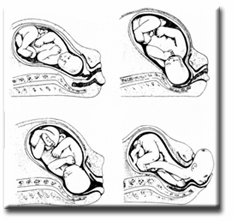 For 9 months, the unborn child has been developing within the womb. Now the fetus is prepared to make an exit. Birth in human beings typically occurs 270 days after conception, near the end of a full 9 months. Shortly before birth (typically a few weeks for first births but sometimes only a few hours for later pregnancies), the fetus usually rotates into a head-downward position. This movement is referred to as lightening because it releases pressure on the mother’s abdomen. Labor is a series of steps your uterus goes through to push out your baby. It may start at any time during pregnancy, but usually begins close to or shortly after your due date.
For 9 months, the unborn child has been developing within the womb. Now the fetus is prepared to make an exit. Birth in human beings typically occurs 270 days after conception, near the end of a full 9 months. Shortly before birth (typically a few weeks for first births but sometimes only a few hours for later pregnancies), the fetus usually rotates into a head-downward position. This movement is referred to as lightening because it releases pressure on the mother’s abdomen. Labor is a series of steps your uterus goes through to push out your baby. It may start at any time during pregnancy, but usually begins close to or shortly after your due date.
It is not known for sure what causes labor to begin. Hormones made by you and your baby and changes in your uterus play a part in starting labor. Contractions of the uterine muscle play part in opening of the hole in the cervix. When dilating occurs, the cervix also effaces, or thins out, as it conforms to the roundness of the presenting part of the baby, usually the head. When the cervix is fully dilated, contractions of the uterus result in the descent of the baby through the pelvic bones. C-section is used when vaginal birth is not possible. Construct a Birth Plan
Labor Checklist
http://youtu.be/i5hAWohZxHE
For women giving birth for the first time, labor will usually last between 12 and 24 hours, with an average of 14 hours. However, for women who have given birth before, labor usually averages only 6 hours.
-
First Stage
First signs of labor
Labor is commonly divided into three stages that typically overlap each other. During the first stage, which lasts, on the average, about 13 hours for a woman having her first child, uterine contractions begin. It was discovered that the levels of a certain enzyme increase dramatically as labor starts. This enzyme chews up the collagen that holds together the fetal membrane, which in turn causes the amniotic sac to rupture (commonly referred to as the time when a woman’s “water breaks.”) The ensuing contractions associated with the rupture are usually spaced from 10 to 20 minutes apart. Initially the contractions are gentle, but they tend to become more powerful and sometimes uncomfortable.
Signs of labor in a nutshell:
Lightening: This is when your “baby drops”. You may feel as if your baby has dropped lower into your abdomen. Your clothes may fit differently. You may find it easier to breathe but may need to urinate more often. This can happen a few weeks to a few hours before labor starts.
Bloody Show: This is also called “show” or “mucus plug”. It is a thick plug of mucus that forms in your cervix during pregnancy. As your cervix gets softer and starts to open, this mucus plug will come out. You will se clear, pink or slightly bloody mucus coming from your vagina. This may happen up to 3 days before labor starts or at the start or labor.
Rupture of Membranes: This is when your “water breaks”. The bag of water is the water-like sack that surrounds the baby during pregnancy. When it leaks or breaks, you may feel a slow trickle from your vagina or sudden gush of warm fluid. this may happen several hours before labor starts or any time during labor.
Braxton-Hicks Labor Pains: These are called false-labor pains or contractions. You probably have had them during the pregnancy. As labor gets closer, these pains may get stronger and closer together. You will know they are not true labor pains because they go away when you walk around or rest. Braxton-Hicks pains are usually felt in your abdomen but not in you back.
When is it time to go to the hospital?
Some mothers prefer not to use hospital facilities and instead give birth at home, usually with a midwife or physician present to help with the delivery However, from 10 to 15 percent of deliveries do require special help. For this reason, unless complete facilities can be made available in the home, doctors usually recommend that mothers be in the hospital or other birthing facility within a few hours after the beginning of labor.
Second Stage
 The second stage of labor usually lasts about 90 minutes. During this stage, the cervix opens sufficiently and the baby begins to move down the birth canal. At this point, if the mother has been well prepared, she may use her abdominal muscles to help push the baby along. This second stage of labor may often be shortened considerably by having the mother give birth in a vertical position, for example, by using a bed or room especially designed to include a birthing bar. When the mother is upright, gravity helps the baby move down the birth canal. Although the second stage of labor usually takes about 90 minutes, the average time in an upright position is only 30 minutes. At the end of the second stage of labor, the baby is born.
The second stage of labor usually lasts about 90 minutes. During this stage, the cervix opens sufficiently and the baby begins to move down the birth canal. At this point, if the mother has been well prepared, she may use her abdominal muscles to help push the baby along. This second stage of labor may often be shortened considerably by having the mother give birth in a vertical position, for example, by using a bed or room especially designed to include a birthing bar. When the mother is upright, gravity helps the baby move down the birth canal. Although the second stage of labor usually takes about 90 minutes, the average time in an upright position is only 30 minutes. At the end of the second stage of labor, the baby is born.
Birth
During birth, the human fetus is forced through the birth canal under extreme pressure and is intermittently deprived of oxygen. During this time, the baby secretes the hormones adrenaline and nor adrenaline, collectively classified as catecholamines, at levels that are higher than they are likely to be at any other time throughout his or her life. Adrenaline helps open up the lungs, dry out the bronchi, and thus achieve the switch from a liquid to an air environment. Nor adrenaline, which is especially prevalent, slows the heartbeat, enabling the fetus to withstand fairly lengthy oxygen deprivation. Babies delivered by Cesarean section, which we will discuss shortly are brought out of the mother surgically and do not pass through the birth canal. Interestingly these infants often have respiratory problems. One reason for such problems might be that the infant has not benefited from the usual stress of birth! At this point an Episiotomy my be needed.
Third Stage
Following the exit of the infant, the third stage of labor occurs, during which the placenta is expelled. The placenta and other expelled materials are called the afterbirth.

Are all babies born in the head-first position?
About 97 percent of babies are born in the head-first position. The fetus’s skull is soft and pliable, which helps the head to pass through the birth canal. However, 2.4 percent of babies are born rump first; this is called a breech birth. During a breech birth, great care must be taken to avoid damage to the baby’s head, which is the most difficult part of the infant’s body to pass through the birth canal. An even rarer occurrence is the shoulder presentation. This occurs in only 1 birth out of 200. The shoulder presentation is extremely dangerous because the baby must be forced by the attendants into a breech position. This forcing can rupture the uterus, which may cause the death of the infant and severe hemorrhaging in the mother.
Another dangerous problem that can occur during birth is anoxia. Anoxia can occur if the placenta detaches prematurely if the umbilical cord is pinched or tangled, if the infant’s head is injured to the point of hemorrhaging, or if the mother has been too heavily sedated during labor. If there is a problem during birth, the child may be removed from the uterus by Cesarean section. Approximately 23% of all births in the United States are Cesarean section. In this procedure, the mother’s abdomen is opened surgically and the baby is removed without passing through the vaginal canal. The surgical incision is then closed as it would be after any other surgical procedure.
Whenever possible, obstetricians use special surgical incisions in the uterus so that a woman who has had one Cesarean section may later deliver babies vaginally With the old Cesarean technique (when a vertical incision was used), once the incision was made and the uterine wall weakened, it was necessary to have any future babies also delivered by Cesarean. It should be noted, however, that women giving birth vaginally for the first time should expect labor to last as long as a typical first-time labor, regardless of how many babies they may have previously had by Cesarean section.In addition, some obstetricians have recommended that Cesarean sections not be used routinely if breech birth or labor problems begin. They argue that breech births for low-weight babies, especially if the obstetrician is skilled, may present no difficulty and that abnormal labor of and by itself is not sufficient cause for a Cesarean section. When it is necessary, however, Cesarean section can be a lifesaver for both infant and mother.
Are your sore after having your baby? Here are some resources